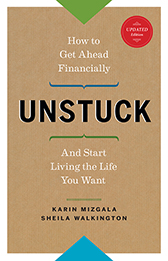By Janet Gray, B.A., B.Admin, CFP®, EPC, CPCA
 I often get asked ‘how can I save more?’ This might help to get you started. Which statement currently best describes your situation?
I often get asked ‘how can I save more?’ This might help to get you started. Which statement currently best describes your situation?
Income minus Savings and Needs = Spending
Or Income minus Spending and Needs = Savings
The first statement is pro-active and ultimately allows you to have savings for your goals. Added bonus- it helps you to live within your means (aka no/minimal additional debt). After paying your essential costs (housing, groceries, debt payments etc), make sure savings are set aside for your most important goals. Your discretionary spending is then the remaining money. Set your goals and prioritize them. Are they a need? Or are they a ‘nice’ to have?
The second statement is more reactive and the result is that sometimes you might save, but more often you can’t. You spend first and then see what is left over for savings. It’s like accidental savings and it often can’t happen because you have already spent too much by the time you get to setting aside savings.
Without being proactive with savings, you will end up spending more than you thought because unexpected or urgent costs will always come up (think car, home, kids or pets). More often than not this leads to a heart-sinking credit card bill or a line of credit that keeps increasing.
What’s a SMART Goal?
The best way to save is to first set SMART goals (Specific, Measurable, Achievable, Relevant and Timebound). Download our Goals Worksheet.
Specific and Measurable because you need to know exactly what you’re trying to achieve and when you’ve achieved it. “Save for the kids’ education” is not a measurable goal. “Save $25,000 for the kids’ education” is measurable. You can plot how to reach that goal, and you’ll know exactly when you’ve achieved it.
Achievable, Realistic and Time-based means that you need to be capable of reaching your goal within a reasonable time frame. This doesn’t mean you can’t set long-term goals! It simply means that you need to be able to break your long-term goal into smaller, manageable goals that you can achieve in shorter time frames.
If you want to save $25,000 for the kids’ education, and the kids are already 14 and 15 and you haven’t even opened an RESP yet, this may not be an achievable goal.
If you want to save $25,000 for the kids’ education and the kids are 2 and 3, this is much more achievable. Break that goal down into year-by-year goals and have at it!
I’ll add one more. Heartfelt means you need to truly want to achieve this goal. You’re most likely to pursue a goal wholeheartedly if you truly believe it’s essential to your happiness – or, in the case of the kids and their education, the happiness of your loved ones.
Map It Out
You may have several goals that you want to achieve, so it begins by organizing them in priority order. This is especially true if your financial situation includes debt, since debt actively drains money away from your goals. Download our Priority Goals worksheet
For example, you might set a goal to pay down your credit card debt. You can then map out how much money you can allocate toward that goal every month and calculate how long it will take you to achieve it.
Once that goal is complete, you’ll have money in your budget that used to go to paying down that credit card debt, and it’s now available to fuel progress toward another goal, like paying off your car loan.
Once that goal has been reached, you might decide to put your money toward investing for retirement.
As you proceed through your list of financial priorities and achieve each goal, you’ll find that you likely have more and more money available to put towards new goals. This means you can achieve your goals more and more quickly.
And if you earn more money, or your investment pays you a dividend, or you happen to get a small windfall along the way? You’ll be glad you have a map and organized priorities, so you know exactly what to do with that money!
What If I Need to Pursue Two Goals?
If you’re new to saving proactively, it may be best to stick to pursuing one goal only at first, until you have a good grasp on your savings plan and can allocate money towards your goal easily.
Once you’re comfortable with saving and have developed the habit, you have the choice. You may want to stick with achieving one goal and then allocating the same resources that funded the first goal toward the next.
Or, you may want to pursue multiple goals at the same time, allocating resources so that each savings fund makes progress. Remember you’ll need to continually revisit your goals as your life shifts and evolves.
The pandemic has caused a lot of my clients to rethink their goals and priorities. Check out my colleague Sheila Walkington’s article: Setting new Financial Goals during the Pandemic
The pro-active and goal-based approach to spending and savings will provide better results in both shorter and longer term. And with less stress and worry at the same time. By changing your thinking, you will see a real difference. Try it.



It would be great if some of these articles could be written geared towards people who are struggling with lower incomes. How does some who was unemployed for a year and barely getting by improve their financial situation?
Thanks for your comment Chante.
The general principles for successful saving are the same regardless of income level: be proactive, and make a plan that has specific, measurable, achievable, realistic, and time-based goals.
However the particular goals will be very different depending on one’s current situation, including income level.
In the case of someone who was unemployed for an extended period, the goals might be focussed around their most pressing concerns, such as re-establishing income, lowering expenses to the minimum to avoid excess debt, and investigating available social supports necessary to weather the crisis, including family, friends, and government services.
Financial advice for those struggling with lower incomes looks very different, and is not our area of expertise. Here are some good resources for lower income earners:
Credit Canada – Money Management for Low Income Families
https://www.creditcanada.com/blog/money-management-for-low-income-families
Financial Planning Association of Canada – Pro Bono Financial Planning Directory
https://www.fpassociation.ca/305565/Page/Show?ClassCode=Page&Slug=pro-bono-financial-planning
Financial Consumer Agency of Canada – Managing financial health in challenging times
https://www.canada.ca/en/financial-consumer-agency/services/covid-19-managing-financial-health.html